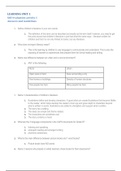LEARNING UNIT 1
Self-evaluation activity 1
Answers and Guidelines
1. Define children‟s literature in your own words.
1. The definition of this term can be described as broadly as the term itself, however, you need to get
the point across that children‟s literature is just that what the name says – literature written for
children and that it is not only limited to books, but any literature.
2. What does emergent literacy mean?
1. This is the learning by children to use language to communicate and understand. This is also the
exposing of learners to experiences that prepare them for formal reading and writing.
3. Name one difference between an urban and a rural environment?
1. ANY of the following:
Rural Urban
Open piece of land Area surrounding a city
Few homes or buildings Density of human structures
Few people live here Many people live here
1. Name 3 characteristics of children‟s literature.
1. Illustrations define and develop characters. A good artist can create illustrations that become lifelike
to the reader, which helps develop the reader‟s inner eye and gives depth to characters beyond
what is written in words. Illustrations are added to strengthen and support what is written.
2. The story has a setting.
3. The ideas are simple and theme related.
4. The characters are sometimes real.
5. The story contains a moral.
2. What are the 3 language components in the CAPS documents for Grade R?
1. listening and speaking
2. emergent reading and emergent writing
3. phonemic awareness.
3. What is the main difference between picture books and 1 word books?
1. Picture books have NO words
4. Name 3 reasons why (based on what) teachers chose books for their classrooms?
, 1. This will help children to make associations with a concept, to extend or elaborate upon on a theme
or for the children‟s independent reading.
2. Many are stories for the stories‟ own sake, because they connect us culturally, address our human
frailties and strengths or help us see beyond ourselves.
3. For reading in a large group of young children, the pictures need to be large and clear enough for
them to be seen at a distance. Some smaller books can still be read aloud to young children when
the illustrations are bold and have a great deal of contrast.
4. Sometimes the reason for selecting a particular book is related to the reading process itself.
5. Analysis of the different genres involves the selection of the book to enhance certain language skills.
5. Name 3 genres in children‟s literature?
1. Nursery rhymes are a genre of their own. Within this genre are traditional rhymes, finger rhymes,
number rhymes, lullabies and action rhymes.
2. Fables
3. Children‟s stories
4. Fairy tales
5. Fantasy fiction
6. Folklore.
,LEARNING UNIT 1
Self-evaluation activity 2
Answers and Guidelines – TRUE and FALSE
1. Africanisation, as defined by Makgoba (1997) above, is a process of exclusion that stresses the importance of
affirming African cultures and identities in a global community.
FALSE. It is a process of inclusion.
2. There are only 2 forms of child maltreatment, including neglect and physical abuse.
FALSE it also includes sexual abuse, exploitation and emotional abuse.
3. When analysing children‟s literature, the following should be considered regarding illustrations; Matching the text
and illustration, Illustrators and Mood of the story.
TRUE
4. Nursery rhymes are a genre of their own. Within this genre are traditional rhymes, finger rhymes, number
rhymes, lullabies and action rhymes.
TRUE
5. The Grade 1–3 Curriculum and Assessment Policy presents the following language components; listening and
speaking, emergent reading and emergent writing, phonemic awareness
FALSE, that is for the Grade R Curriculum
6. Language development is NOT one of the critical aspects of a child‟s development.
FALSE, it is.
7. The purpose of children‟s literature is to provide children with the opportunity to respond to literature and
develop their own opinions about a topic.
TRUE
, LEARNING UNIT 1
Self-evaluation activity 3
Answers and Guidelines – Multiple Choice
1. Children‟s literature, the body of written work and accompanying illustrations are produced in order to:
a. entertain or instruct young people
b. entertain or instruct young people
c. entertain or instruct young people but can also be enjoyed by older people
2. Nursery Rhymes are a genre on their own and include:
a. traditional rhymes, finger rhymes, number rhymes, lullabies and action rhymes
b. traditional rhymes, lullabies and action rhymes
c. traditional rhymes, finger rhymes and number rhymes
3. When reading books to a large group of children, you may read:
a. ONLY books where the pictures are large and clear enough for them to be seen at a distance
b. ONLY smaller books can still be read aloud to young children when the illustrations are bold and
have a great deal of contrast
c. ALL of the above
4. Africanisation means:
a. Stories must be related to the African tradition or background
b. When teaching children‟s literature, teachers need to take the context of the children into
consideration
c. It is the aggregate of social and cultural conditions influencing the life of an individual or community
5. The purpose of children‟s literature is to
a. Provide children with the opportunity to respond to literature and develop their own opinions about a
topic
b. Give children your opinion about a topic
c. Teach children there is only one opinion and that is the one they must learn to adapt
6. The balance approach to language will be successful if the following is integrated in a stimulating environment:
a. Reading, writing, listening and speaking
b. Reading and writing
c. Listening and understanding




